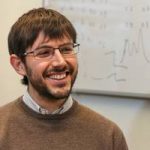
Michele Ceriotti, new tenure-track assistant professor and head of the Laboratory of Computational Science and Modelling at EPFL, doesn’t like to make definitive decisions. Faced with the prospect of choosing between physics and chemistry as an undergraduate at the University of Milan-Bicocca, he opted to study the multidisciplinary field of materials science. When deciding on a specialisation as a PhD student at ETH Zurich, he selected computer modelling.
“Simulation allows me to wear multiple hats and change what I’m working on very quickly,” Ceriotti said. “It takes lots of effort and resources to build a new laboratory just to investigate an idea. Using a computer as a virtual laboratory only requires changing a few lines of code.”
Ceriotti researches and develops techniques for computer simulation of materials at the atomic level. That is, he aims to reproduce atomic motion and behaviour at the nanoscale to improve our understanding of mechanisms that account for macroscopic properties, and to then improve these properties through rational design. While computers can now give accurate predictions about material properties such as conductivity and brittleness when fed descriptive parameters, the real goal should be to predict trends and identify critical properties.
“Basically, I try to simulate how atoms behave,” he said. “I want to figure out what we can learn about the behaviour of materials, and infer from the microstructure information about how to make materials better.”
Though the specific techniques vary depending on the application, all simulations need to be accurate, predictive and able to capture both subtle physical effects and complex, large-scale structural features. For now, Ceriotti plans to focus his research on materials such as amorphous silicon that can be used in energy applications, and also on metals. He also wants to develop techniques that contribute to the development of sustainable materials that are easier to recycle and less environmentally damaging to make.
“I think that right now, at the academic level, one is mostly interested in getting materials with exceptional properties and performance,” he said. “Typically, we choose a material to work on and think about how to design it, but we don’t think about how much of it there is on Earth, how polluting it will be, or how easily we’ll be able to recycle it. Steering materials science into a more environmentally aware direction will be a big challenge over the next 10 years.”
Ceriotti intends to make it easy for other people to use the methods he develops and is already collaborating with other research groups from Stanford to Trieste. He also wants to use CCMX’s connections to work more closely with industry, notably Switzerland’s metal companies, who are constantly seeking better alloys and more easily processed materials.
He’d also like to see his methods help other scientists in a wide range of fields.
“What has given me the most satisfaction over the last few years was when someone took my methods and used them to accomplish something non-trivial,” he said. “That is, when my work can act as a stepping-stone to accomplish something I had not foreseen.”
Traditional simulation models treat atomic nuclei as classical particles, describing them with the same equations as billiard balls or planets. This approximation works well for heavier elements, but is problematic for lighter atoms such as hydrogen. Making this assumption about hydrogen nuclei would, for example, suggest that water has a pH of 8.5. During a post-doc at Oxford, Ceriotti developed a technique for simulating nuclei as quantum particles. A researcher at Lawrence Livermore National Laboratory used the method to study hydrogen at very high pressure, an important element of understanding giant planets and astrophysical phenomena.
“It was nice to see someone put my research to use in a field so completely different from mine,” he said.
Text by Carey Sargent (March 2014)